NCC: Land Lines – The joy of doing nothing, except hanging out with puffins
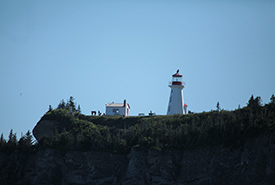
Île aux Perroquets and the historic lighthouse. (Photo courtesy of Quincin Chan)
This blog was written by Wendy Ho as told by Quincin Chan
The St. Lawrence River holds a special place in my heart. It was part of my three-week honeymoon camping road trip in Quebec years ago. Fast forward seven years and two kids later, we took our kids on a road trip to the St. Lawrence River again this summer for a chance to relive these memories and create new ones with our children. One highlight of our summer vacation was spending time on a small island named for its Atlantic puffin colony in the Gulf of St. Lawrence.
Île aux Perroquets, just off of Longue-Pointe-de-Mingan, is the most western island on the Mingan Archipelago. This island supports tens of thousands of Atlantic puffins. From mid-April to September, this species steals the show among other seabirds and is a big attraction for nature lovers. These seabirds experienced population decline in the 1900s due to a history of poaching and egg collecting, which led to this island’s inclusion in the Brador Bay Migratory Bird Sanctuary in 1925.
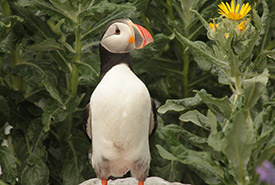
With plumage that resemble a black tuxedo over a white dress shirt during breeding season and a big, colourful bill, puffins give the impression of a sharply dressed fellow. (Photo by Yves Cheung)
During this leg of the trip, we stayed in a historic lighthouse keeper’s house that was converted to a cozy inn. For two days, we enjoyed the quiet company of a few other overnight guests and explored the island’s birdlife. Tourists and hardcore photographers also came and went on day tours to marvel at puffins, razorbills and swallows.
Being one with nature
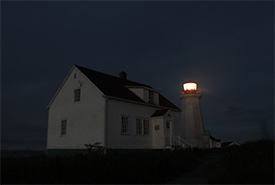
At the crack of dawn when I was still asleep inside the inn, my husband ventured out for some bird watching. (Photo by Yves Cheung
There wasn’t much to do in the form of entertainment except to slow down and watch the windswept cliffs and shores, and, of course, the seabirds. Albeit a little “boring” according to my kids, the island was bustling with puffin activities, akin to High Park in Toronto and its squirrels. We watched young puffins, distinguished by their dark bills and dark areas around the eyes, learn to fly. Although they were less graceful than the adults, we couldn’t help but quietly cheer them on, like we did when our kids took their first steps.
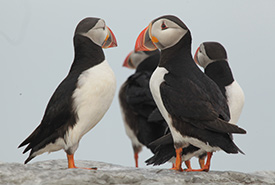
Atlantic puffins were numerous when we visitied and such a delight to watch (Photo by Yves Cheung)
Just before the crack of dawn at 4:30 a.m. when I was still in bed with my two young kids, my husband ventured out to the rocky beach and sat down to become a fly on the wall among the colony. He observed the quirks and quacks of puffin life for hours, and the puffins seemed comfortable with this still-as-a-rock outsider on the sidelines, and at times waddled within arms’ reach (of course, he didn’t touch the wildlife). The way he described his time with the puffins, I can tell he really enjoyed being immersed in nature. He didn’t take many photos or try to fiddle with camera settings for low-light photography; he just soaked in the moment, taking in the sounds, smells and sights.
The puffins’ morning commute
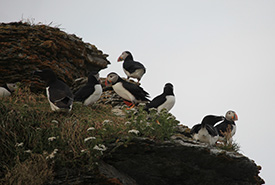
Puffins on the cliff edge (Photo by Yves Cheung)
Around 5 a.m., the puffins began their fishing trips and headed out to sea in a seemingly orderly and circular route. The pufflings waited at the entrance of their burrow, eager for a mouthful of fish from returning parents. Perhaps just a fun anecdote, but my husband observed polite puffin behaviour, as described by the park’s guide. It is said that puffins will check to see that the coast is clear (free of puffin neighbours that might get hit from above) before they poop outside their burrows. Razorbills, another colonial seabird inhabiting the area, would not care as much.
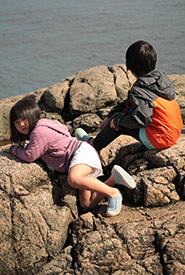
Heidi and Damien sitting by the rocks and taking in the ocean view. (Photo by Yves Cheung)
During this trip, we tried to soak in everything that nature had to offer, resisting the urge to check in with the online world. My hope is for our kids to be inspired with each nature interaction, as we hope we are making a bigger impact on their young minds. I’m not rushing to make them understand conservation at the moment, but by exposing them to experiences and teaching them one fact at a time, I’m confident that one day they’ll put the pieces together.
The Atlantic puffin is one of 30 species and habitats featured in NCC’s gift giving campaign: Gifts of Canadian Nature. To learn more and to give the gift of conservation this holiday season, click here.




